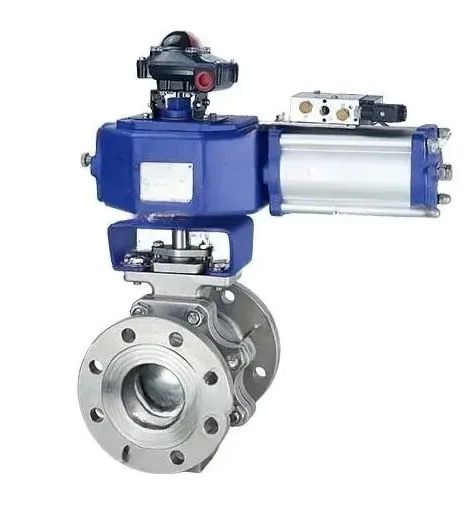Introduction
Pneumatic ball valves are vital components in modern fluid and gas control systems. Designed to regulate the flow of liquids and gases, these valves use a rotating ball mechanism to either allow or block flow through a pipeline. What sets pneumatic ball valves apart is their integration with pneumatic actuators, which harness compressed air to rotate the valve ball. This design offers quick actuation, reliable performance, and cost-efficiency, making them highly popular across various industrial sectors.
This article provides a comprehensive overview of pneumatic ball valves, covering their working principles, key components, connection types, installation guidelines, and essential maintenance practices to ensure optimal performance and longevity.
What Is a Pneumatic Ball Valve?
A pneumatic ball valve comprises two main parts:
- Ball Valve – Features a hollow, perforated ball that controls flow. When the hole aligns with the pipeline, fluid passes through; when rotated 90°, the flow is blocked.
- Pneumatic Actuator – Converts compressed air into mechanical motion to turn the valve.
There are two types of pneumatic actuators:
- Single-Acting Actuator: Uses air to open or close the valve, with a spring returning it to its default position when air is removed. Ideal for fail-safe scenarios.
- Double-Acting Actuator: Uses air pressure to operate in both directions, offering better control and reliability in continuous-use environments.
Advantages: Pneumatic ball valves offer rapid actuation, superior durability under pressure and temperature extremes, and lower costs compared to electric actuators—especially in larger valve sizes.
Key Components of Pneumatic Ball Valves
- Pneumatic Actuator: The driver that uses compressed air to rotate the valve. Usually mounted via an ISO 5211 flange for easy interchangeability.
- Ball Valve Body: Contains the rotating ball with a central bore. Flow is controlled based on the orientation of this bore relative to the pipeline.
- ISO 5211 Flange: A standardized mounting interface that ensures compatibility between actuators and valves. Common sizes include F03, F04, and F05.
- Springs and Seals: Ensure tight sealing and reliable return-to-position actuation. Critical for leak prevention and fail-safe operations.
5 Common Connection Types for Pneumatic Ball Valves
- Flanged Connection
- Uses flanges and gaskets for a robust, bolted connection.
- Ideal for medium to large pipelines due to ease of installation and maintenance.
- Threaded Connection
- Features male or female threads for quick installation.
- Best for compact systems and lower-pressure applications.
- Tri-Clamp Connection
- Common in food, beverage, and pharmaceutical sectors.
- Offers hygienic, tool-free assembly using clamps.
- Wafer Type
- Mounted between two pipe flanges using bolts.
- Cost-effective and compact, ideal for tight spaces.
- Welded Connection
- Permanently welded to the pipeline for a leak-proof joint.
- Suited for high-pressure, high-temperature, and hazardous applications.
How Pneumatic Ball Valves Work
The actuator receives compressed air, which rotates the ball 90 degrees to open or close the valve:
- Open Position: The bore of the ball aligns with the flow path, allowing media to pass.
- Closed Position: The bore is perpendicular to the flow, blocking passage completely.
This simple yet efficient design allows pneumatic ball valves to deliver reliable, repeatable performance in demanding environments such as chemical processing, water treatment, and oil & gas.
Installation Considerations
- Environmental Factors
- Ensure valve components can withstand the operating pressure, temperature, and type of fluid or gas.
- Safety
- Follow all safety protocols during installation, including PPE use and pressure testing procedures.
- Compatibility
- Verify actuator torque ratings, valve pressure classes, and connection types are matched correctly.
- Serviceability
- Allow space for access and maintenance. Choose installation locations that facilitate future inspections or replacements.
Maintenance and Troubleshooting
Routine Maintenance Tips
- Visual Inspections
- Check regularly for corrosion, leakage, or actuator damage.
- Seal and Gasket Check
- Inspect and replace worn seals to prevent air or media leaks.
- Lubrication
- Keep moving parts properly lubricated using compatible lubricants to prevent premature wear or sticking.
- Air Quality
- Ensure clean, dry air supply. Use filters and dryers to avoid damage from contaminants or moisture.
Common Troubleshooting Tips
- Actuator Fails to Operate
- Check for proper air supply pressure and cleanliness. Inspect air lines for blockages or leaks.
- Valve Stuck Open or Closed
- Could indicate internal obstruction or actuator failure. Disassemble and clean or replace faulty parts.
- Leakage from Connections
- Tighten all fittings or replace faulty seals/gaskets. Avoid over-tightening, which can damage threads.
- Excessive Wear
- May be due to overpressure or chemical incompatibility. Ensure valve materials match your application specifications.
Conclusion
Pneumatic ball valves offer a powerful combination of speed, reliability, and affordability in fluid and gas control systems. Their straightforward design and ease of integration with automated systems make them ideal for applications across industries. By understanding their components, selecting the right connection type, and following best practices for installation and maintenance, you can ensure long-term performance and prevent costly downtime.
Whether you're planning a new installation or maintaining an existing setup, pneumatic ball valves remain a practical and efficient choice for modern industrial operations.Know more about Google SEO Directory





Comments